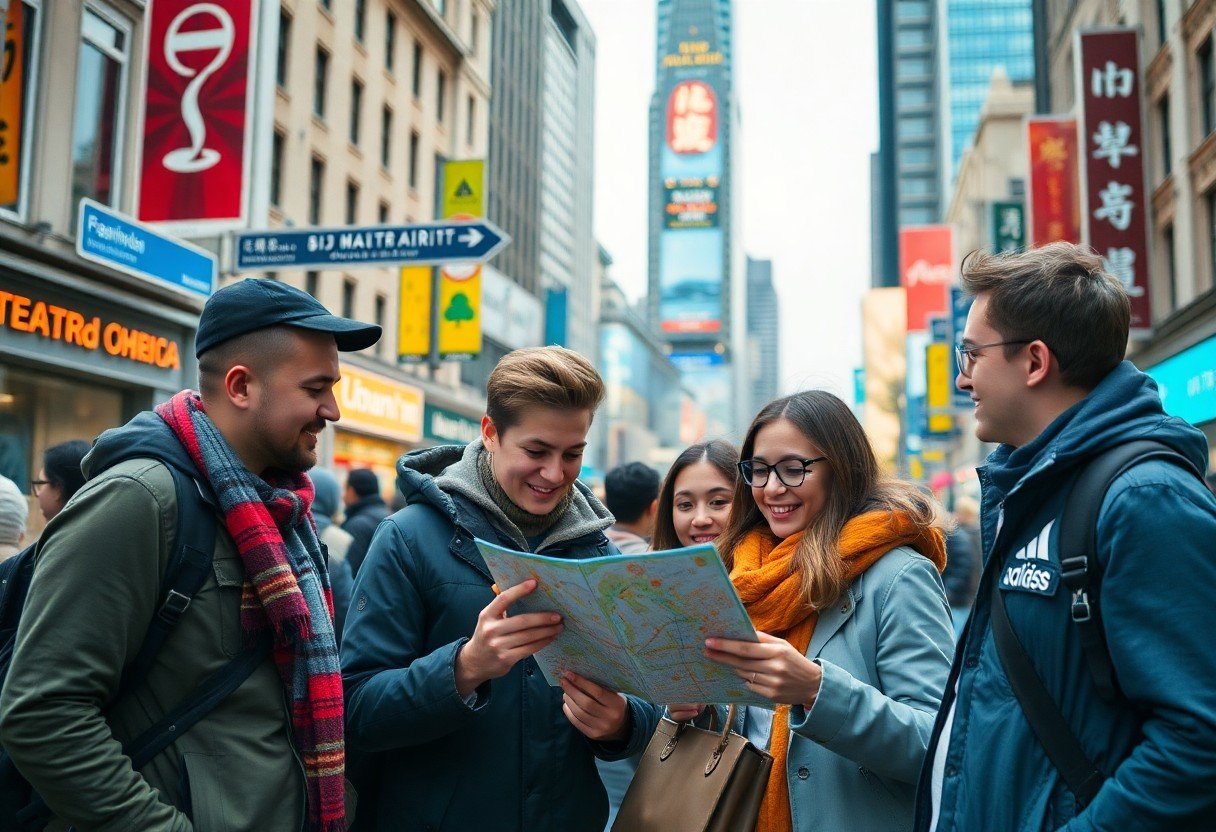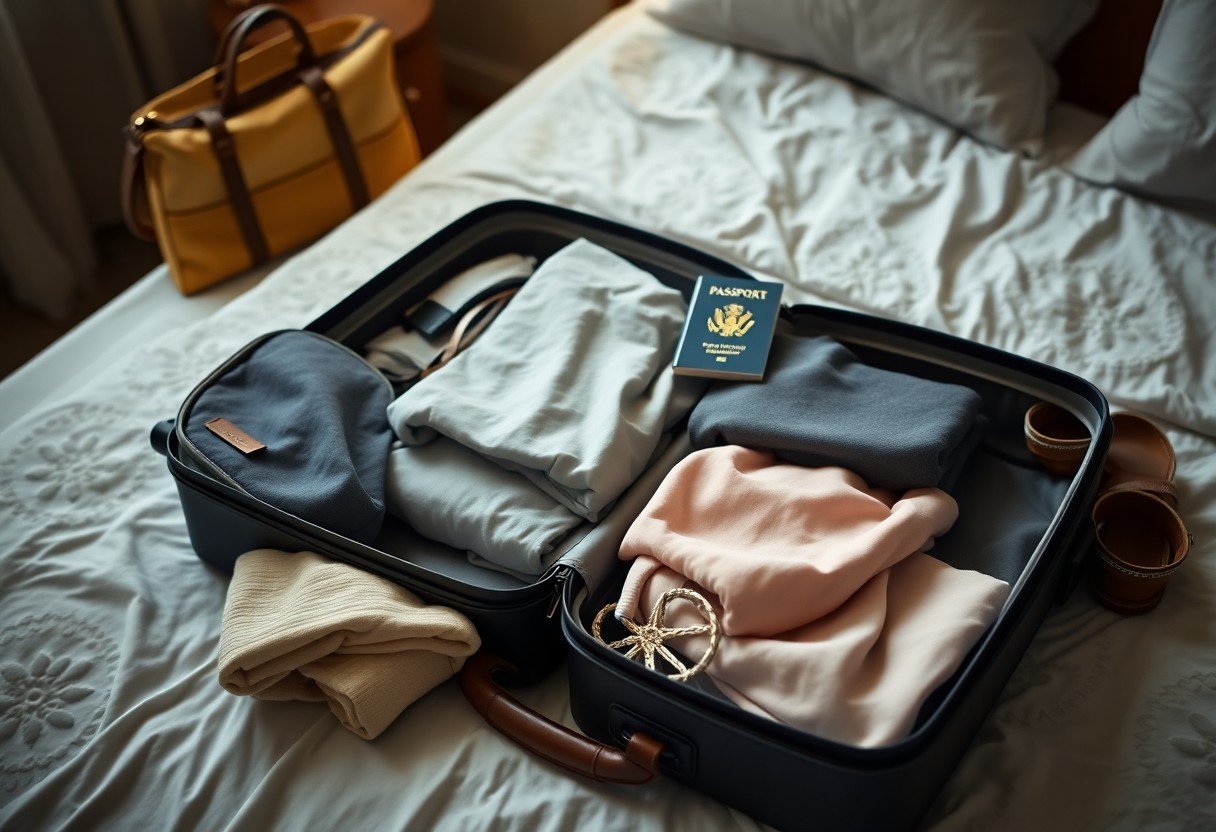Traveling in foreign cities can be an exhilarating yet daunting experience. To help you make the most of your adventure, this guide provides important tips that will enhance your journey and keep you safe. You’ll learn how to efficiently navigate public transport, communicate with locals, and avoid common pitfalls that may arise while exploring new destinations. With practical advice and insightful suggestions, you’ll gain the confidence to immerse yourself in different cultures while ensuring a smooth travel experience.

Key Takeaways:
- Familiarize yourself with local customs and etiquette to enhance interactions with residents.
- Use downloadable maps and translation apps to ease navigation and communication.
- Learn key phrases in the local language to boost confidence and connect with locals.
- Plan your routes in advance, including public transport options, to save time and avoid confusion.
- Stay aware of your surroundings and keep personal belongings secure to ensure a safe experience.
Types of Transportation
The variety of transport options available in foreign cities can significantly impact your travel experience. You can choose from different modes of transportation based on your preferences, convenience, and budget. Familiarizing yourself with these options will make navigating through unfamiliar areas more manageable. Here are some common types of transportation:
| Public Transport | Buses, trams, subways, and trains |
| Ride-Sharing | Services like Uber and Lyft |
| Taxis | Traditional taxi services |
| Bicycles | Rental bikes or bike-sharing programs |
| Walking | Exploring on foot for short distances |
Recognizing the different transportation options can empower you to make informed choices during your travels.
Public Transport Options
Some cities boast extensive public transport systems that can help you reach your destination efficiently and affordably. Subways offer a fast way to navigate through larger urban areas, while buses can take you to less accessible neighborhoods. In many places, you’ll find multi-day passes or single-ride tickets that provide flexibility based on your travel schedule. Combining these options can minimize travel times and enhance your experience.
Using public transport not only saves money but also immerses you in the local culture, providing a glimpse into the daily lives of the residents. However, it’s imperative to check the schedule and routes in advance to avoid confusion. Local apps can help you track your journey in real time and ensure you arrive at your destination with minimal hassle.
Private Transport Solutions
The use of private transportation can provide you with more flexibility and comfort compared to public options, especially when traveling with luggage or in groups. You can opt for traditional taxis, which are widely available in most cities, or utilize ride-sharing services that connect you with nearby drivers through a smartphone app. This can give you the advantage of door-to-door service without the wait associated with public transport.
Understanding how to navigate private transport solutions can enhance your travel experience. While taxis can sometimes be more expensive, they offer a level of comfort and convenience, especially during late-night travel or to areas not serviced by public transport. Additionally, ride-sharing apps often allow you to select vehicle types based on your budget and privacy preferences. However, be cautious of surge pricing during peak hours and ensure that your driver is authorized and verified for your safety.
Tips for Planning Your Route
One way to ensure a smooth travel experience is by carefully planning your route in advance. A bit of preparation can save you time and enhance your enjoyment of the city’s attractions. Here are a few strategies to keep in mind:
- Identify the key sights you want to visit.
- Consider public transportation options and their schedules.
- Factor in your personal interests, such as restaurants and shops.
- Use a map to sketch out a general itinerary.
- Be aware of any local events that might affect road conditions.
Assume that some areas might be less tourist-friendly and plan accordingly to avoid getting lost or experiencing delays during your exploration.
Using Maps and Navigation Apps
Any trip can be enhanced by utilizing the right maps and navigation apps. These tools will guide you through unfamiliar streets, ensuring you reach your destination efficiently. Popular options like Google Maps or Waze provide real-time traffic updates and can often suggest alternate routes to avoid congested areas. Additionally, many of these apps allow you to download maps for offline use, an crucial feature when your data connection is unreliable.
You should also familiarize yourself with the mapping features in your app of choice. Being able to customize your route, such as selecting the mode of transport—walking, public transit, or driving—will empower you to navigate the city like a local. Don’t hesitate to ask for recommendations or tips from fellow travelers or locals for even better route planning.
Timing Your Travel Wisely
Wisely managing your travel schedule can enhance your overall experience in a foreign city. It’s important to consider the times when attractions are less crowded to maximize your enjoyment. Visiting popular sights early in the morning or later in the afternoon can help you evade the bulk of tourist traffic. Additionally, research the hours of operation for the places you plan to visit, as different days may have varying schedules.
Another critical point to keep in mind is that public transportation may follow a different timetable on weekends or holidays, which could impact your travel plans. By checking transit schedules in advance, you can avoid long waits and potential disruptions. Additionally, local rush hours can lead to overcrowded buses or trains, so plan your journeys accordingly to minimize discomfort. Ultimately, being informed about timing allows you to explore with greater ease and joy.
Step-by-Step Guide to Local Etiquette
All travelers should prioritize understanding the local culture and customs to enhance their experience and show respect toward the host community. This chapter breaks down important local etiquette in a simple guide, so you can navigate any foreign city with confidence and grace.
Understanding Cultural Norms
| Behavioral Aspect | Expected Norms |
|---|---|
| Greetings | Know if handshakes, hugs, or bows are preferred. |
| Dining Etiquette | Understand if meals are shared or if there are specific manners to observe. |
| Dress Code | Be aware of local traditions regarding appropriate attire. |
| Public Behavior | Learn how to conduct yourself in public spaces and interactions. |
Understanding Cultural Norms
Any traveler venturing into a new destination should familiarize themselves with the dominant cultural customs of the area. This understanding will not only prevent unintentional offenses but also enrich your travel experience. Different countries may have varying expectations regarding personal space, gift-giving, and communication styles.
Furthermore, the way you engage with locals can greatly influence their perception of you as a traveler. You should always approach interactions with an open mind and a willingness to learn. A respectful attitude can foster meaningful connections and create lasting memories as you navigate the vibrant tapestry of local life.
Language Tips for Communication
Local languages can significantly enhance your communication abilities while traveling. Local proficiency isn’t always necessary, but showing an effort can go a long way. Try to remember a few key phrases in the native language, such as greetings and expressions of gratitude. This small gesture demonstrates respect and can even open doors to friendly interactions.
- Learn Basic Phrases: Start with “hello,” “thank you,” and “goodbye.”
- Use Translation Apps: Familiarize yourself with technology to assist.
- Practice Pronunciation: Locals appreciate your attempts to speak their language.
Local customs often include speaking softly in public or observing silence on public transport, so it’s key to adjust your language use. After taking the time to learn these communication tips, you’ll likely find that interactions with locals will be more favorable and enjoyable.
More on Language Tips for Communication
Localizing your communication practices strengthens connections and builds rapport with the people you encounter. Along with learning basic phrases, consider utilizing body language and gestures to aid understanding. Visual cues can enhance your communication, especially in cases where language barriers are significant. Locals may break into smiles or assistance when they see you trying to communicate effectively.
- Non-Verbal Cues: Use gestures and facial expressions to your advantage.
- Adaptability: Be flexible and receptive to local dialects.
- Politeness: Always approach conversations with a courteous demeanor.
After mastering these communication techniques, you’ll find that interacting with locals not only becomes less intimidating but also more enjoyable, enriching your travel experiences.
Tips
Local etiquette can be tricky, but you can navigate it smoothly with a few insightful strategies. Pay close attention to the local customs and be prepared to adjust your behavior as you engage with different cultures. This adaptability can open doors to positive interactions.
- Observe the Locals: Take cues from those around you.
- Be Mindful of Rules: Respect local regulations at all times.
- Express Gratitude: A simple “thank you” can enhance your connection.
After embracing the local etiquette, you’ll not only be respected but also welcomed into the community, creating lasting memories and enriching your travel experience.
Factors to Consider When Choosing Destinations
Your travel experience begins with selecting the right destination. When making your choice, it’s crucial to evaluate various factors that align with your travel goals. Think about the culture, languages spoken, and the local climate. These elements can significantly enhance your trip. Create a checklist with these considerations:
- Safety of the area
- Accessibility for your specific needs
- Local attractions and amenities
- Budget for expenses
- Language barriers and communication options
The right destination should fit your travel style and preferences, ensuring a fulfilling experience throughout your journey.
Safety and Accessibility
Any wise traveler should prioritize safety when selecting a destination. Research crime rates, political stability, and public health information to ensure you will be in a secure environment. Additionally, consider the accessibility of the area, especially if you have specific mobility needs. Evaluate airport transfers, public transport availability, and the distance to your accommodation from significant attractions. The right choice can make all the difference in ensuring a comfortable, worry-free trip.
Local Attractions and Amenities
Destinations with appealing local attractions can provide a memorable experience. Look for sites that resonate with your interests, whether they be historical landmarks, stunning nature spots, or vibrant urban experiences. Additionally, you should consider the availability of amenities, such as quality restaurants, convenient shopping options, and crucial services like healthcare. Researching these features can help enhance your overall travel experience.
It’s crucial to assess both the types of local attractions and the variety of amenities available in your chosen destination. The presence of engaging activities, such as museums or outdoor adventures, can keep you entertained. Furthermore, easy access to high-quality accommodations and dining options ensures your needs are met while you explore. The blend of culture and comfort will create a rich travel experience that you will cherish long after your return.
Pros and Cons of Different Travel Styles
Many travelers often find themselves at a crossroads when deciding on their travel style, each with its own set of advantages and challenges. Understanding the pros and cons of various approaches can help you make an informed decision, ensuring that your trip aligns with your personality and preferences. Below is a summary of the most common travel styles, highlighting their benefits and drawbacks:
| Travel Style | Pros | Cons |
|---|---|---|
| Backpacking | Affordable, flexibility, and immersion in local culture | Physical strain, safety concerns, and less comfort |
| Luxury Travel | Comfort, exclusive experiences, and personalized service | High costs and limited local interaction |
| Group Tours | Convenience, organization, and social connections | Less flexibility and potential for group conflict |
| Solo Travel | Complete freedom, self-discovery, and tailored itineraries | Isolation and safety concerns |
| Road Trips | Freedom to explore and flexibility in scheduling | Driving fatigue and potential navigation issues |
| Volunteering Abroad | Meaningful experiences and cultural immersion | Commitment time and potential exploitation risks |
| Adventure Travel | Excitement and unique experiences | Increased risk and physical demands |
| Cultural Tours | Educational and insightful | Structured schedules and possible lack of spontaneity |
| Eco-Tourism | Conscious travel and local support | Higher costs and limited availability |
| Staycations | Cost-effective and familiar | Less excitement and potential for boredom |
When considering your travel style, it’s beneficial to explore different perspectives, which is why you might find interesting insights on How to navigate in foreign countries? : r/travel.
Backpacking vs. Luxury Travel
One of the biggest contrasts in travel styles is between backpacking and luxury travel. If you’re the type who enjoys the thrill of adventure, interacting closely with local culture, and maximizing your budget, backpacking may be the appropriate choice for you. Typically, backpacking involves staying in hostels, using public transportation, and exploring lesser-known attractions. However, it often comes with the downside of physical exertion and the need for constant vigilance regarding your belongings.
On the other hand, luxury travel offers an experience filled with comfort, high-end amenities, and curated experiences. This style allows for personalized service and unique opportunities, but it often comes at a significantly higher cost and can limit your direct engagement with the local culture. Ultimately, your choice between these two depends on what you value in your journey—adventure or comfort.
Group Tours vs. Solo Adventures
There’s a growing debate among travelers regarding group tours versus solo adventures. Group travel grants you a ready-made social experience, with organized itineraries and the convenience of having everything planned out. Yet, it can also mean adhering strictly to schedules and compromising your personal preferences. If you thrive on interaction and friendship, group tours can enrich your travel experience.
To explore deeper, solo adventures allow you the freedom to craft your own itinerary and explore at your own pace. However, this freedom comes with its own set of risks, such as potential feelings of isolation and safety concerns. While group tours can help mitigate the challenges of navigating foreign cities, it’s important to weigh the benefits against the drawbacks to decide which travel style fits you best.
Practical Packing Tips for Foreign Cities
After deciding on your travel destination, one of the most vital components of a successful trip is ensuring you have the right items packed for navigating foreign cities. Practical packing not only makes your journey easier but can also enhance your overall experience. Consider the following tips for your packing strategy:
- Prioritize versatile clothing that can be layered.
- Include a comfortable pair of walking shoes.
- Pack a compact day bag for daily excursions.
- Bring a portable charger to keep your devices powered.
- Don’t forget necessary travel documents and local currency.
Recognizing that every inch of space in your suitcase matters can save you time and stress later on during your travels.
Essentials to Bring
Little details can make a world of difference when you’re traveling. Ensure that you pack necessary items like a travel adapter, as different countries have varying plug types and voltage. A first-aid kit can also be beneficial for unexpected situations. Additionally, make sure to include any necessary medications, as some may not be readily available abroad or may differ in formulation.
Adapting to Local Weather
Clearly, checking the weather forecast for your destination before packing is a wise strategy. Whether you’re heading to a sunny beach or a chilly mountaintop, tailoring your clothing accordingly can greatly enhance your comfort. Pack breathable fabrics for warm climates and thermal layers for cooler, wetter climates. You may also need an umbrella or a waterproof jacket if rain is expected.
For instance, if you are traveling to a tropical destination, lightweight, quick-drying clothing is advantageous for both comfort and practicality. Conversely, colder locations may require you to invest in warm accessories, such as gloves, hats, and scarves. Additionally, remember that weather can change unexpectedly, so having a mix of layering options allows you to adapt to fluctuating conditions. Recognizing the importance of weather-appropriate packing ensures you fully enjoy your time exploring foreign cities without letting climate-related discomfort impede your adventures.
Final Words
Ultimately, navigating foreign cities can be an enriching yet daunting experience. With the right strategies and tools at your disposal, you can explore new destinations with confidence. Familiarizing yourself with public transportation options, utilizing offline maps, and learning key phrases in the local language can help you move seamlessly through unfamiliar landscapes. Keep an open mind and allow yourself to adapt as you venture off the beaten path. For more insights on managing your map navigation in Europe, check out [How to have map navigation in Europe](https://community.ricksteves.com/travel-forum/tech-tips/how-to-have-map-navigation-in-europe).
As you launch on your travels, focus on the joy of discovery and the unique experiences that lie ahead. Each city has its own charm, and by employing these quick travel tips, you’ll enhance your ability to enjoy all that it has to offer. You can become a more savvy traveler, ensuring that you maximize your time while minimizing stress. Embrace the adventure and let your curiosity guide you through the wonders of each new destination.




